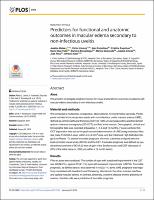| dc.contributor | Vall d'Hebron Barcelona Hospital Campus |
| dc.contributor.author | Matas, Jessica |
| dc.contributor.author | Llorenç, Victor |
| dc.contributor.author | Fonollosa, Alex |
| dc.contributor.author | Esquinas López, Cristina |
| dc.contributor.author | Diaz-Valle, David |
| dc.contributor.author | Berasategui, Barbara |
| dc.date.accessioned | 2019-03-01T11:15:10Z |
| dc.date.available | 2019-03-01T11:15:10Z |
| dc.date.issued | 2019-01-24 |
| dc.identifier.citation | Matas J, Llorenç V, Fonollosa A, Esquinas C, Diaz-Valle D, Berasategui B, et al. Predictors for functional and anatomic outcomes in macular edema secondary to non-infectious uveitis. PLoS One. 2019;14(1):e0210799. |
| dc.identifier.issn | 1932-6203 |
| dc.identifier.uri | https://hdl.handle.net/11351/3822 |
| dc.description | Predictors; Macular edema; Non-infectious uveitis |
| dc.description.abstract | AIMS:
We aimed to investigate predictive factors for visual and anatomic outcomes in patients with macular edema secondary to non-infectious uveitis.
MATERIAL AND METHODS:
We conducted a multicenter, prospective, observational, 12-month follow-up study. Participants included in the study were adults with non-infectious uveitic macular edema (UME), defined as central subfoveal thickness (CST) of >300 μm as measured by spectral domain optical coherence tomography (SD-OCT) and fluid in the macula. Demographic, clinical and tomographic data was recorded at baseline, 1, 3, 6 and 12 months. Foveal-centered SD-OCT exploration was set as the gold-standard determination of UME using a standard Macular Cube 512x128 A-scan, within a 6 x 6 mm2 area, and the Enhanced High Definition Single-Line Raster. To assess favorable prognosis, the main outcomes analyzed were the best-corrected visual acuity (BCVA) and the CST. Favorable prognosis was defined as sustained improvement of BCVA (2 lines of gain of the Snellen scale) and CST (decrease of 20% of the initial value or <300 μm) within a 12 month period.
RESULTS:
Fifty-six eyes were analyzed. The number of eyes with sustained improvement in the CST was 48 (86.2%), against 23 (41.1%) eyes with sustained improvement in BCVA. Favorable prognosis, as defined above, was observed in 18 (32.1%) eyes. UME prognosis was negatively correlated with baseline foveal thickening, alteration in the vitreo-macular interface and cystoid macular edema. In contrast, bilaterally, systemic disease and the presence of anterior chamber cells were predictive of favorable prognosis.
CONCLUSION:
Available treatment modalities in UME may avoid chronic UME and improve anatomic outcome. However, the proportion of functional amelioration observed during 12 months of follow-up is lower. Thicker CST, alteration in the vitreo-macular interface and cystoid macular edema may denote less favorable prognosis. Conversely, bilaterally, systemic disease and anterior chamber cells may be associated with favorable prognosis in UME. |
| dc.language.iso | eng |
| dc.publisher | Public Library of Science |
| dc.relation.ispartofseries | PLoS ONE;14(1) |
| dc.rights | Attribution-NonCommercial-NoDerivatives 4.0 International |
| dc.rights.uri | http://creativecommons.org/licenses/by-nc-nd/4.0/ |
| dc.source | Scientia |
| dc.subject | Uveïtis |
| dc.subject | Edema - Tractament - Estudi de casos |
| dc.subject.mesh | Macular Edema |
| dc.subject.mesh | Uveitis |
| dc.subject.mesh | /drug therapy |
| dc.subject.mesh | Cohort Studies |
| dc.title | Predictors for functional and anatomic outcomes in macular edema secondary to non-infectious uveitis |
| dc.type | info:eu-repo/semantics/article |
| dc.identifier.doi | 10.1371/journal.pone.0210799 |
| dc.subject.decs | edema macular |
| dc.subject.decs | uveítis |
| dc.subject.decs | /tratamiento farmacológico |
| dc.subject.decs | estudios de cohortes |
| dc.relation.publishversion | https://journals.plos.org/plosone/article?id=10.1371/journal.pone.0210799 |
| dc.type.version | info:eu-repo/semantics/publishedVersion |
| dc.audience | Professionals |
| dc.contributor.organismes | Institut Català de la Salut |
| dc.contributor.authoraffiliation | [Matas J, Llorenç V] Clinic Institute of Ophthalmology (ICOF), Hospital Clinic of Barcelona, Barcelona, Spain. August Pi i Sunyer Biomedical Research Institute (IDIBAPS), Barcelona, Spain. [Fonollosa A] Department of Ophthalmology, BioCruces Health Research Institute, Hospital Cruces, University of the Basque Country, Baracaldo, Spain. [Esquinas C] Vall d’Hebron Institut de Recerca, Barcelona, Spain. Universitat Autònoma de Barcelona, Barcelona, Spain. [Diaz-Valle D] Ophthalmology Department and Health Research Institute (IdISSC), Hospital Clinic of San Carlos, Madrid, Spain. [Berasategui B] Department of Ophthalmology, BioCruces Health Research Institute, Hospital Cruces, University of the Basque Country, Baracaldo, Spain. |
| dc.identifier.pmid | 30677041 |
| dc.identifier.wos | WOS:000456700400026 |
| dc.rights.accessrights | info:eu-repo/semantics/openAccess |

